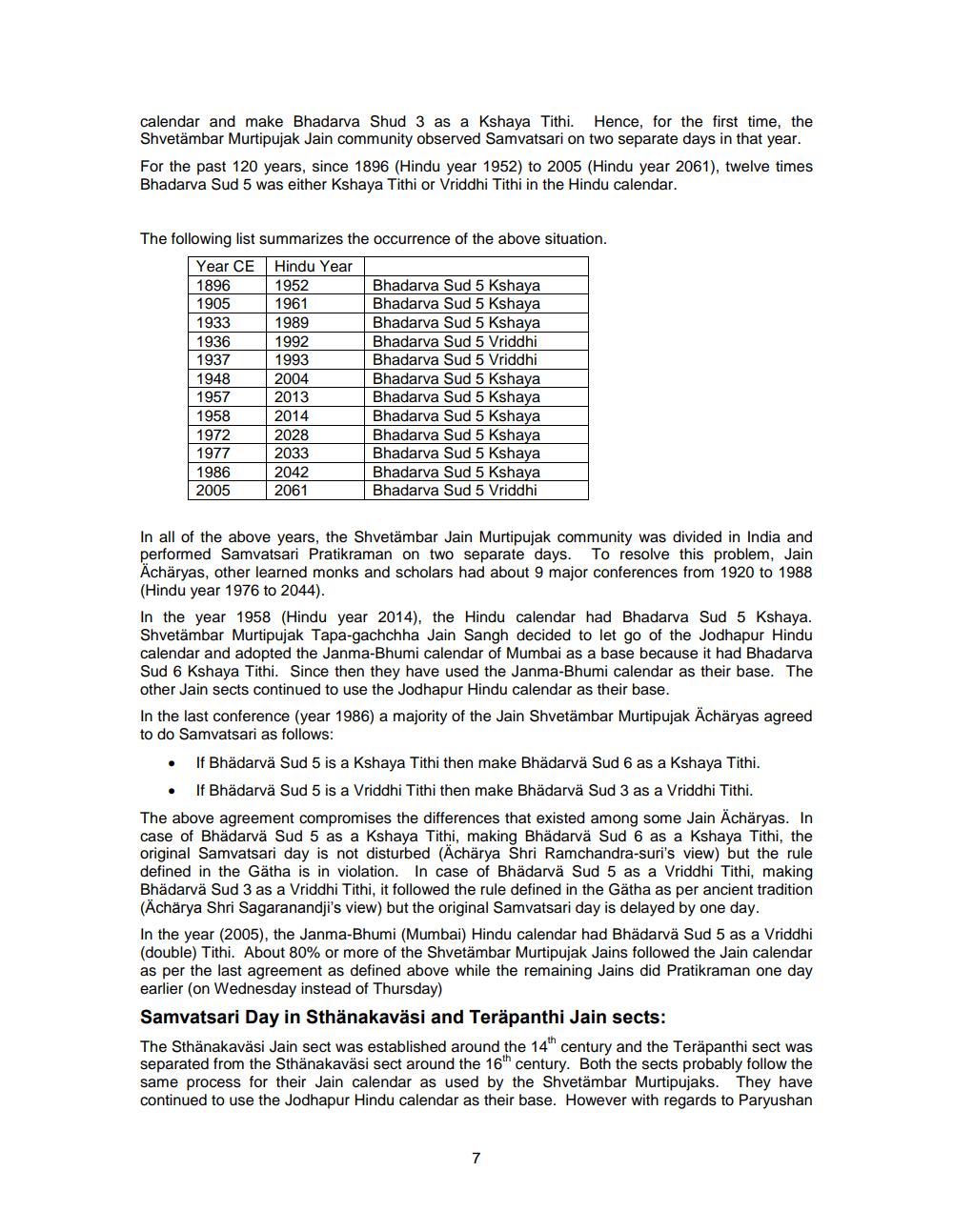Book Title: Samvatsari Tithi Article V4 20120905 Author(s): Pravin K Shah Publisher: JAINA Education Committee View full book textPage 7
________________ calendar and make Bhadarva Shud 3 as a Kshaya Tithi. Hence, for the first time, the Shvetämbar Murtipujak Jain community observed Samvatsari on two separate days in that year. For the past 120 years, since 1896 (Hindu year 1952) to 2005 (Hindu year 2061), twelve times Bhadarva Sud 5 was either Kshaya Tithi or Vriddhi Tithi in the Hindu calendar. The following list summarizes the occurrence of the above situation. Year CE Hindu Year 1896 1952 1905 1961 1933 1989 1936 1992 1937 1993 1948 1957 1958 1972 1977 1986 2005 2004 2013 2014 2028 2033 2042 2061 Bhadarva Sud 5 Kshaya Bhadarva Sud 5 Kshaya Bhadarva Sud 5 Kshaya Bhadarva Sud 5 Vriddhi Bhadarva Sud 5 Vriddhi Bhadarva Sud 5 Kshaya Bhadarva Sud 5 Kshaya Bhadarva Sud 5 Kshaya Bhadarva Sud 5 Kshaya Bhadarva Sud 5 Kshaya Bhadarva Sud 5 Kshaya Bhadarva Sud 5 Vriddhi In all of the above years, the Shvetämbar Jain Murtipujak community was divided in India and performed Samvatsari Pratikraman on two separate days. To resolve this problem, Jain Ächäryas, other learned monks and scholars had about 9 major conferences from 1920 to 1988 (Hindu year 1976 to 2044). In the year 1958 (Hindu year 2014), the Hindu calendar had Bhadarva Sud 5 Kshaya. Shvetämbar Murtipujak Tapa-gachchha Jain Sangh decided to let go of the Jodhapur Hindu calendar and adopted the Janma-Bhumi calendar of Mumbai as a base because it had Bhadarva Sud 6 Kshaya Tithi. Since then they have used the Janma-Bhumi calendar as their base. The other Jain sects continued to use the Jodhapur Hindu calendar as their base. In the last conference (year 1986) a majority of the Jain Shvetämbar Murtipujak Ächäryas agreed to do Samvatsari as follows: ⚫ If Bhädarvä Sud 5 is a Kshaya Tithi then make Bhädarvä Sud 6 as a Kshaya Tithi. • If Bhädarvä Sud 5 is a Vriddhi Tithi then make Bhädarvä Sud 3 as a Vriddhi Tithi. The above agreement compromises the differences that existed among some Jain Ächäryas. In case of Bhädarvä Sud 5 as a Kshaya Tithi, making Bhädarvä Sud 6 as a Kshaya Tithi, the original Samvatsari day is not disturbed (Ächärya Shri Ramchandra-suri's view) but the rule defined in the Gätha is in violation. In case of Bhädarvä Sud 5 as a Vriddhi Tithi, making Bhädarvä Sud 3 as a Vriddhi Tithi, it followed the rule defined in the Gätha as per ancient tradition (Ächärya Shri Sagaranandji's view) but the original Samvatsari day is delayed by one day. In the year (2005), the Janma-Bhumi (Mumbai) Hindu calendar had Bhädarvä Sud 5 as a Vriddhi (double) Tithi. About 80% or more of the Shvetämbar Murtipujak Jains followed the Jain calendar as per the last agreement as defined above while the remaining Jains did Pratikraman one day earlier (on Wednesday instead of Thursday) Samvatsari Day in Sthänakaväsi and Teräpanthi Jain sects: The Sthänakaväsi Jain sect was established around the 14th century and the Teräpanthi sect was separated from the Sthänakaväsi sect around the 16th century. Both the sects probably follow the same process for their Jain calendar as used by the Shvetämbar Murtipujaks. They have continued to use the Jodhapur Hindu calendar as their base. However with regards to Paryushan 7Page Navigation
1 ... 5 6 7 8 9 10
